
Lower tensions with countless data to watch!
After weeks of heightened anticipation, Israel has responded to a previous Iranian missile attack, mobilizing over 100 aircraft, including advanced F-35 jets, in a strategic operation spanning 2,000 kilometers. This measured response, potentially influenced by Democratic policymakers in the U.S., signals an effort to temper aggressive actions ahead of the U.S. presidential election, raising the likelihood of relative stability in the region through this critical period.
On the economic front, the coming week promises to be significant, with a focus on key U.S. labor data, updated economic activity numbers from China, European GDP releases, and an array of corporate earnings reports. Let’s delve into these financial indicators and what they could mean for the global economy in the days ahead.
US: Labor Data in Focus Amid Political and Economic Uncertainty
Last week, U.S. housing data took center stage, with existing home sales continuing to slump while new home sales rose solidly, showing mixed signals in the sector. Additionally, Federal Reserve officials fueled uncertainty over future interest rate cuts, lending strength to the U.S. dollar. Earnings season also brought some optimism, as a majority of reports exceeded expectations, lifting market sentiment despite broader pressures.
This week, economic indicators are set to dominate, with Wednesday’s GDP numbers, Thursday’s Personal Income and Spending data, and key Employment figures throughout the week. With less than ten days until the U.S. presidential election, the close race could bring additional market volatility, especially if one candidate takes a lead in pivotal swing states. Investors will be watching closely, balancing economic signals with the political landscape to gauge potential impacts on markets and the Fed’s policy path.
On Tuesday, the CB Consumer Confidence and JOLTS (Job Openings and Labor Turnover Survey) reports will provide valuable insights into U.S. economic sentiment and labor market resilience. October’s CB Consumer Confidence is anticipated to remain below 100, with a slight improvement expected toward 98.8–99 following last week’s positive economic surprises. Meanwhile, JOLTS data for September is projected to remain robust, with job openings potentially staying above 8 million. The August report showed a strong 8.04 million, and recent positive weekly labor data suggests continued resilience in the job market.
This Wednesday, Q3 GDP growth estimates are expected to show a slight uptick to 3.2%, building on Q2’s 3.0% rise. As with Q2, consumer activity—especially in the service sector—is anticipated to drive growth, with personal consumption expenditures (PCE) forecasted to increase by 3.6%. While a cooling labor market may lead to gradual moderation, robust consumer demand is likely to continue supporting the economic outlook in the coming quarters.
On Thursday, attention will turn to the Fed’s preferred inflation measure, the Core PCE Price Index, alongside detailed data on Personal Income and Spending. Despite the challenges faced this year, 2024 has shown positive growth and stability in personal consumption. Consumers are now in a stronger position than previously thought, with recent trends indicating that income growth has outpaced spending, leading to an increase in the personal saving rate to nearly 5%, up from 3% earlier this year. For September, we anticipate personal income and spending to grow by 0.4% each. We also expect the PCE deflator to rise by 0.2%, with core PCE projected to increase by 0.2% as well. If these forecasts hold true, the year-over-year PCE deflator would reach 2.0%, in line with the Fed’s inflation target.
The upcoming October jobs report, set for release on Friday, presents a complex picture. The ongoing strike at Boeing has affected 33,000 union workers, resulting in furloughs for some non-union employees. Additionally, the impact of hurricanes complicates the assessment of nonfarm payroll growth, which we anticipate will fall sharply this month. Despite these challenges, we expect the unemployment rate to remain steady at 4.1%, as striking workers are counted as employed in household surveys, while furloughed workers are not.
In contrast, the September jobs report showed unexpected strength, with employers adding 254,000 new jobs—the highest monthly gain since March. This was accompanied by positive revisions for the previous two months, leading to a decrease in the unemployment rate to a four-month low of 4.1%. For October, we predict an additional 140,000 jobs, but we expect to see signs of a slight cooling in the labor market in the coming months. This softer backdrop is likely to limit average hourly earnings growth, which we project will increase by 0.3% in October.
The coming week will be packed with Q3 earnings reports from major players like Alphabet (Google), Visa, AMD, McDonald’s, Pfizer, PayPal, Microsoft, Meta Platforms, Eli Lilly, Booking, Airbus Group, Apple, Amazon.com, Uber Tech, Exxon Mobil, Chevron, and Mastercard. Overall, we anticipate positive results across these companies. However, strong economic data could reinforce skepticism about the pace of interest rate cuts, potentially putting pressure on stock markets. Added to this, election-related uncertainties may continue to weigh on sentiment, likely extending last week’s slight downward trend.
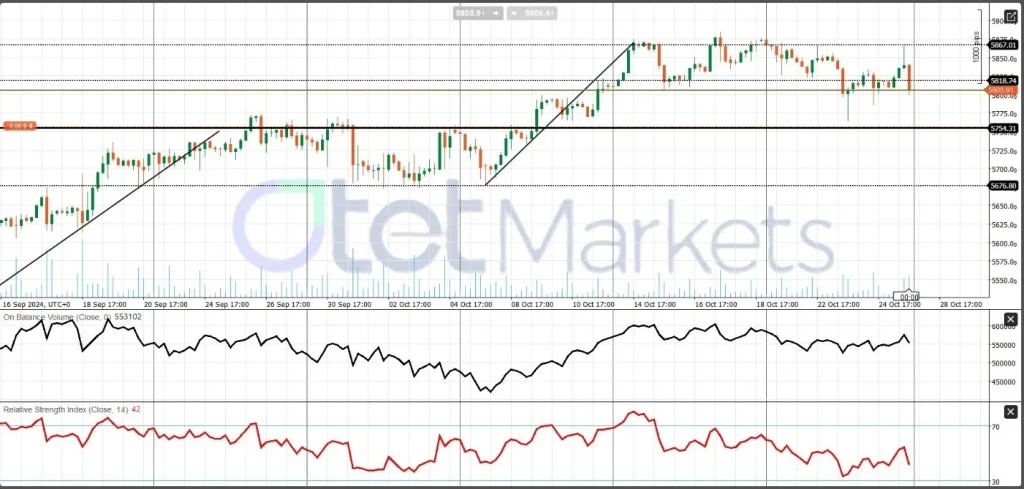
On the currency front, similar factors that may pressure stock markets could support the USD. Technically, while bullish momentum is softening, the overall trend remains positive, with solid support around 103.0.

JPY and BoJ Policy Meeting
In Japan, the Bank of Japan’s (BOJ) rate decision is expected this week, with most forecasts pointing to rates remaining at 0.25%, as JPY OIS reflects an 83.8% probability of a hold. While Japan’s new prime minister supports more dovish policies to boost economic growth, Governor Ueda’s recent remarks suggest the possibility of a policy shift that could surprise markets. Ueda’s hawkish comments highlight risks from prolonged low rates, which could lead to speculative pressures, potentially supporting the JPY.
On the data front, Japanese inflation in October 2024 showed signs of easing. The Tokyo CPI (year-over-year) rose 1.8%, down from 2.1%, while the Tokyo Core CPI (excluding fresh food) increased by 1.8%, slightly above the forecasted 1.7% but below last month’s 2.0%. Additionally, the Tokyo CPI excluding food and energy (month-over-month) grew by 0.4%, reversing a previous decline of -0.2%. This data signals a moderation in overall inflationary pressures in Japan, though core inflation remains slightly above expectations.
Looking ahead, with the BOJ’s decision to focus on yen traders, Japan’s weekend elections add a layer of political uncertainty. A weaker result for the ruling LDP could pressure the BOJ’s policy direction. We anticipate the BOJ will hold rates next week but may resume hikes in 2025, with potential 25 bps increases in January and April supported by solid inflation, wage growth, and GDP trends.
In the currency markets, a sideways movement in the USDJPY chart is anticipated ahead of the NFP results, with a slight correction expected as markets brace for potential BoJ intervention. From a technical standpoint, while the general upward trend persists, bullish momentum could extend further.
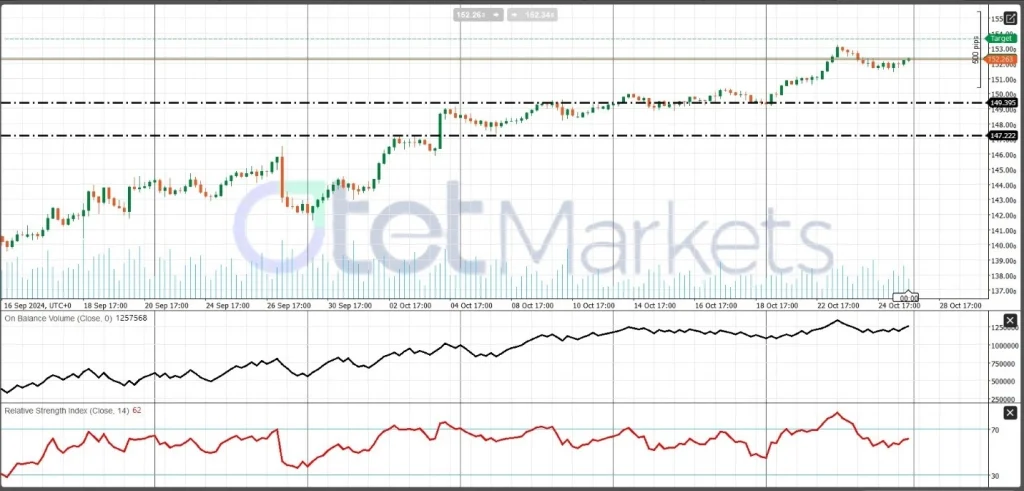
Gold: A Pause Before the Next Leap?
With market uncertainties, elevated risks, and ongoing geopolitical tensions, investors are turning to gold as a safe haven, pushing prices to new highs. Recently, gold reached over $2,750 per ounce, marking a 26% gain year-to-date. Central banks are also increasing their gold reserves, moving away from the US dollar as a primary reserve asset—a trend now placing gold ahead of the euro as the second-largest reserve asset globally, according to the Bank of America.
Investor demand in gold-backed ETFs, combined with expectations of potential rate cuts from the Federal Reserve, bolsters confidence in gold’s long-term value. As a non-interest-bearing asset, gold remains attractive in a lower-rate environment, especially with renewed political tensions.
On the geopolitical side, temporary easing in tensions following Israel’s response to an Iranian missile incident could allow market risks to stabilize, potentially strengthening the USD in the short term and signaling a correction for gold before the next rally.
Technical View
The $2,740 level is key support for gold. Remaining above it would favor the bulls, while a dip below could set correction targets at $2,720 and $2,700.
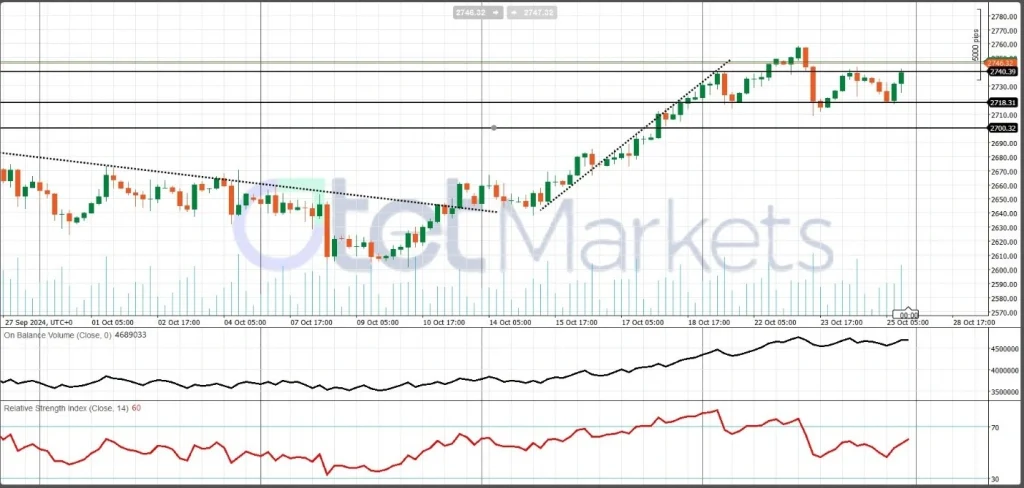
Oil Prices, Geopolitical Developments, and Chinese Demand
Last week, oil prices dipped following U.S. Secretary of State Antony Blinken’s optimism about potential ceasefire talks in Qatar between Israel and Hamas. Additionally, Israel’s restrained response to Iran, which included no attacks on oil resources, has contributed to the ongoing pressure on oil prices.
With geopolitical tensions cooling for the short term and market uncertainty rising ahead of the U.S. elections, a positive reaction in the energy market seems unlikely. However, as winter approaches and energy demand increases, this could impact demand levels, especially alongside weakening industrial demand.
Furthermore, we do not anticipate any significant surprises in the Chinese PMI data set to be released later this week. Conversely, the natural gas market surged, partly due to weather factors and supply drops, signaling potential shifts in energy markets. Therefore, we expect oil prices to remain stable near $70 per barrel as markets monitor further developments.
From a technical perspective, we anticipate an expected range of $69 to $72 per barrel for the week ahead, as none of the indicators currently favor either bulls or bears.
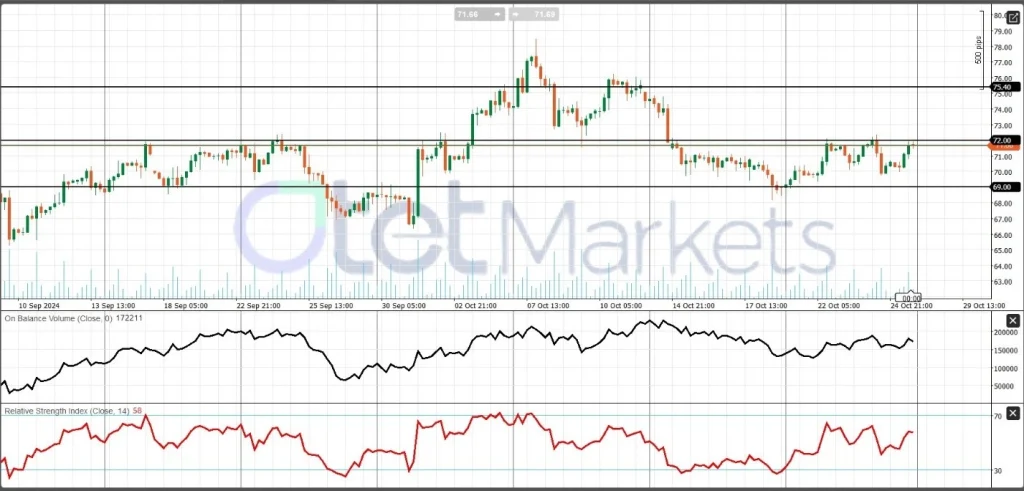
On October 23, the Pennsylvania House of Representatives approved HB-2381, a pro-crypto bill designed to protect self-custody and digital asset payments, with an overwhelming vote of 176 to 26. Drafted by the Satoshi Action Fund, the bill must now clear the Pennsylvania Senate and receive Governor Josh Shapiro’s signature to become law. This legislation underscores that support for Bitcoin transcends party lines, resonating with voters who prioritize economic freedom, technological innovation, and digital privacy.
Bitcoin also provides an alternative to central bank digital currencies (CBDCs), a significant concern for many voters. Despite recent challenges stemming from unfavorable U.S. crypto policies, industry leaders remain optimistic about potential regulatory changes with a new administration on the horizon.
Additionally, during the Asian trading session on October 25, the expiration of $5.26 billion in Bitcoin and Ethereum options exerted short-term pressure on BTC prices, which may continue to face headwinds as the U.S. election approaches amid rising uncertainty.
From a technical perspective, both the Relative Strength Index (RSI) and On-Balance Volume (OBV) indicate this correction, with strong support identified at the $64,000 level.
Share
Hot topics

Best Forex Trading Hours for Iranian Traders
The Forex market operates 24-hours a day, but clearly not every hour, equal it could even be every trading session, is profitable. There are times when the market sleeps, is...
Read more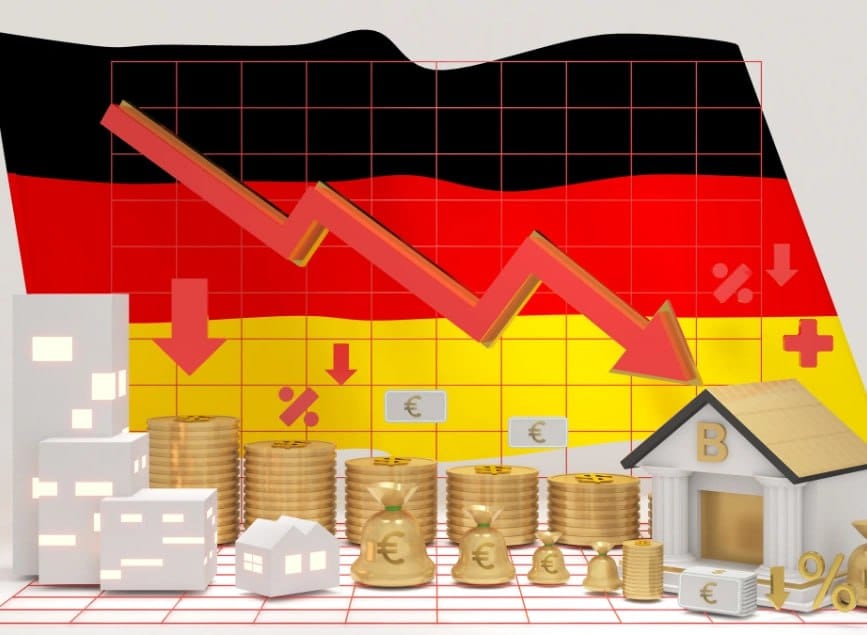




Submit comment
Your email address will not be published. Required fields are marked *